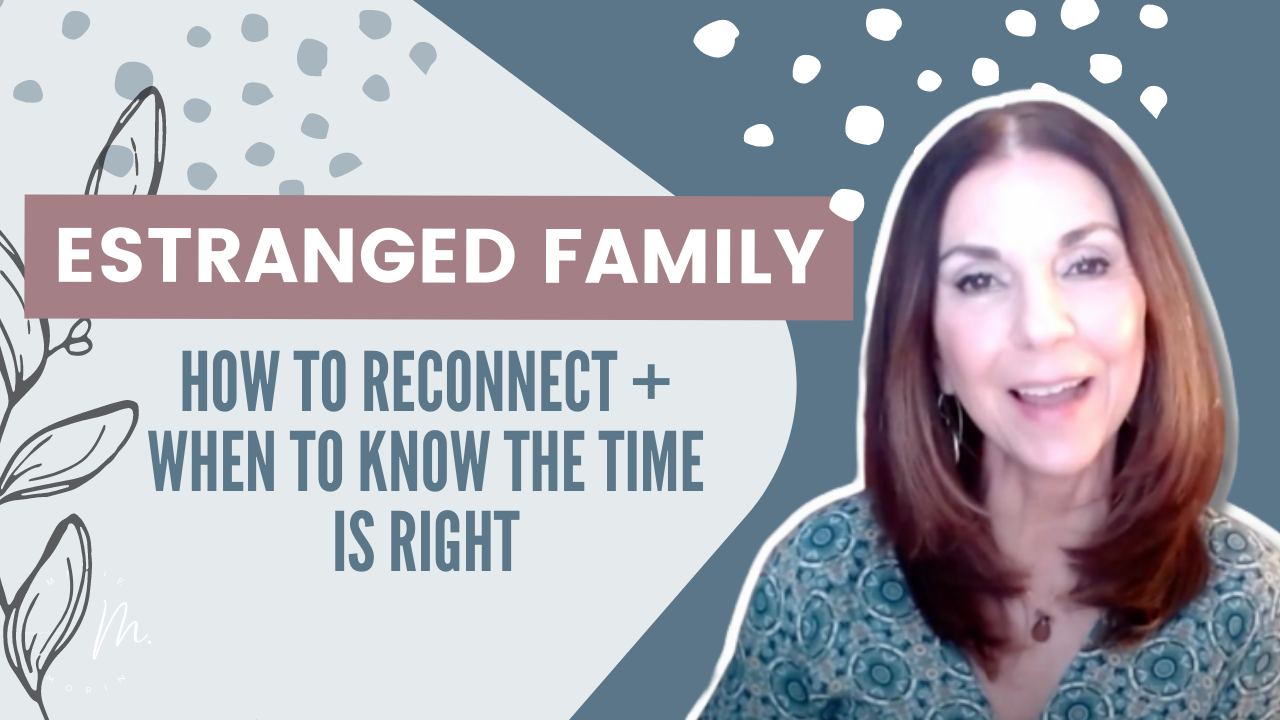Are you wondering if it is possible to try and end the rift with your family member? Maybe you have been thinking about reconnecting for some time, but are worried about what might happen. Since reconciling requires both parties to move toward each other, there is the risk that your loved one may be unwilling and or disinterested. For those interviewed that took the first step, they noticed that circumstances had changed, they began imagining and strategizing a plan, and they discerned a sign. This article discusses the three nudges before Reconnecting With an Estranged Family and How to Know the Time is Right.
Reconciliation
Reconciling with estranged family members is the act of coming to a truce. To reconcile is to make amends, settle a dispute, and call for a cease-fire. Often there is no way to reconcile the two versions, and reconciliation is accepting that fact. Reconcilers of estrangement were willing to relinquish needing to win their point. To reconcile is when two opposing viewpoints relate to one’s resigning, the need for both sides to agree on one narrative.
Family estrangement is when one member intentionally decides to detach from others. Parting creates an emotional and or physical distance that is emotionally troublesome for all involved. The complicated nature of the process and elements of estrangement are as varied as the individual stories. Estrangement can be a grueling condition with no one size fits all solution. Many estranged, including the parents of estranged adult children, hoping for reconciliation benefit by learning communication skills, caveats, and breathing exercises to better cope with inner turmoil.
Research
Dr. Karl Pillemer, sociologist and researcher, and his team interviewed 100 estranged individuals who reconciled. In his book, Fault Lines, Fractured Families and How to Mend Them, he describes the strategies of successful reconcilers abandoning the need for an apology, having their loved ones align with their side of the story, and being willing to move into a new future relationship. In addition, he found that three ideas prodded them before these reconcilers took action,
Reconcilers thought about anticipatory regret or the idea of how they would feel if they did not reconcile. Getting back into the family became a value they wanted to regain since family members often take sides. They were willing to proceed to arrive at the fullness of the family experience. Lastly, successful reconcilers were inclined to take the risk to gain interpersonal resources, such as having someone to count on and speak with regularly.
What preceded the decision to attempt reconciling are Pillemer’s “nudges.” These individuals had been contemplating for many years the fragmented relationship. Some had sought support through therapy; their stories spanned years of challenging loss and grief. In time, they began to move forward by exploring alternative narratives to their original perceptions of what caused the rift. They prepared by working on themselves. But, before they acted, they noticed three proddings.
Dr. Karl Pillemer’s Three Nudges
1. The Circumstances Have Changed
A noticeable change occurs that impacts the status of the estrangement. For example, if an estranged sibling married to an intolerable controlling spouse passes away. The modified element was the obstacle that participated in the estrangement dynamics. Or, your now sober estranged may be more willing to reconcile. A different recognizable circumstance has now opened the possibility of connecting.
2. You Start Developing a Plan
Dr. Pillemer suggests that if you find yourself considering how you will reconnect, it may indicate that you are ready to give it a try. You may be imagining yourself reconnecting in different ways. Or You might ponder making the phone call or writing a letter. When your vague urges to reconcile become solid strategies, you may be ready to move forward.
3. Look For A Sign
You are noticing more than before your estranged family member comes up in conversations with other family members. Perhaps a story you read with people with an account of reconnecting incites awareness into your estranged relationship. You may be studying and discovering the power of forgiveness and decide it is time. Pillemer recounts a story of one reconciler who knew in his gut and ran to the phone to call his brother. Interestingly, successful reconcilers recalled a precise moment they knew the time was right to try.
Before reconcilers acted by knowing that circumstances had changed, they kept thinking about the possibility and designed a plan, and they felt there was a sign that it was time to try. You may be wondering if it is worth the chance that things will go south? Or are you worried about how you will keep your cool if your estranged loved one triggers you?
What if they refuse? Sadly, your preparation does not guarantee your loved one will align with your desire. However, the better path in your ambiguous journey is to move forward despite the potential outcome.
Five Mistakes
Dr. Joshua Coleman, in his book, Rules of Estrangement Why Adult Children Cut Ties and How to Heal the Conflict, encourages parents to avoid certain practices. Coleman’s common mistakes are valuable for all relationships. Often, family dynamics prevail, and individuals resort to behaviors they may regret. Behaviors include motivating your estranged family member with guilt and returning fire with fire. Thirdly, believing that reconciliation should be based on fairness. Fourth make excuses for what your child (or estranged family member) is telling you they think of what you did by defending, explaining, or persuading, and neglecting to recognize how long reconciliation can take and not noticing progress.
Conclusion
The act of reconnecting is courageous and well prepared. One does not train for a marathon by running a few miles. Instead, it is the precise determination to train consistently, to improve for the long, arduous process. Reconcilers moved forward when they were ready, circumstances had changed, and they knew the time was right. After contemplating and preparing, they were willing to act.
Estrangement and the state of disconnection from a father, mother, sister, brother, or adult child causes enormous pain and potentially chronic stress. While waiting patiently or impatiently for the day when you might reconcile with your family member, informing yourself and doing self-care will give you both tools and approaches that help. Most importantly, expand your focus to build your inner foundation. Be prepared for the likelihood of stressful situations by learning communication skills, doing daily self-care, practicing mindfulness, finding gratitude, and practicing self-compassion.
It is risky to reconnect when there are family rifts. Successful reconcilers were prepared and reported the benefits were worth the effort. Dr. Karl Pillemer’s research found that reconcilers noticed that circumstances had changed, they began imagining and strategizing a plan, and they discerned a sign. This article discusses the three nudges before Reconnecting With an Estranged Family and How to Know the Time is Right.
Get The eBook: Feeling Heartbroken and Alone? How to Pick Up the Pieces When You are Estranged.
Resources:
- Agllias, Kylie. Family Estrangement A Matter Of Perspective. New York, Routledge, 2017.
- Coleman, Joshua. Rules of Estrangement. New York, Harmony Books, 2020.
- Morin, Marie. Feeling Heartbroken and Alone? How to Pick Up the Pieces When You are Estranged. eBook. 2022.
- Morin, M.L. [Morin Holistic Therapy]. (2022, January 4 ). What is Family Estrangement? You Are Not Alone.
- Morin, M.L. [Morin Holistic Therapy]. (2021, September 8). Diaphragmatic Breathing: 5 Minute Deep Breathing Exercise for Beginners.
- Morin, Marie. How to Deal with Estranged Family During the Holidays (2021, November 21) Sixty and Me. https://sixtyandme.com/estranged-family-holidays/
- Pillemer, Karl. Fault Lines Fractured Families and How to Mend Them. New York Penguin Random House, 2020.





